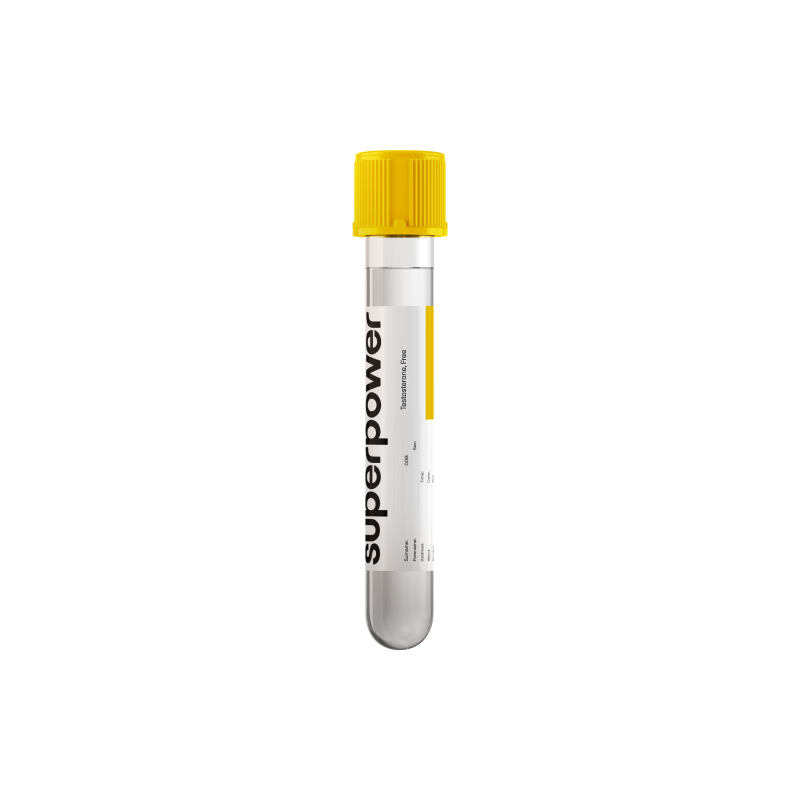Measure your free testosterone levels with Superpower.
Get precise insights into energy, muscle health, mood, and overall performance with simple at-home testing.
Key Benefits
See the testosterone your body can actually use (free, unbound).
- Spot hormone imbalance driving low libido, fatigue, or erectile issues in men.
- Flag androgen excess behind acne, hair growth, or irregular periods in women.
- Clarify borderline totals when binding proteins shift from obesity, thyroid, liver, or aging.
- Guide treatment for low testosterone or polycystic ovary syndrome using bioactive levels.
- Protect fertility by identifying androgen imbalances affecting ovulation or sperm production.
- Track therapy response and avoid overtreatment by monitoring free levels over time.
- Best interpreted with total testosterone, binding proteins, and your symptoms, measured morning.
What is Testosterone, Free?
Free testosterone is the small portion of testosterone in your blood that is not attached to carrier proteins. Testosterone is a steroid sex hormone (an androgen) made mainly by the testes (Leydig cells) in males, and in smaller amounts by the ovaries and adrenal glands in females. In circulation, most testosterone is bound tightly to sex hormone–binding globulin (SHBG) or loosely to albumin. The free fraction is not bound and is immediately available to enter cells and act on tissues.
Because it can slip into cells and activate the androgen receptor, free testosterone drives testosterone’s effects: sexual development and function, libido, maintenance of muscle and bone, red blood cell production, and aspects of mood and energy. It therefore reflects the active hormonal signal reaching tissues (bioavailable androgen activity) more directly than the total amount present in blood. Changes in SHBG can shift how much testosterone is free, so the free fraction captures the body’s usable androgen level at a given time.
Why is Testosterone, Free important?
Free testosterone is the small, unbound fraction of testosterone that can enter cells and signal directly. It influences brain drive and mood, muscle and bone strength, red blood cell production, sexual function, and metabolism in both men and women. Reference ranges differ by sex, age, and lab method; adult men’s typical range is far higher than women’s, and children’s rises during puberty. Many people feel best when free testosterone sits in the middle to upper part of their sex- and age-specific range, though individual set points vary.
When free testosterone is lower than expected for age and sex, it reflects reduced production (testes or ovaries/adrenals), decreased pituitary signaling, illness, or higher binding proteins (especially increased SHBG, as in pregnancy or hyperthyroidism). Men may notice low desire, fewer morning erections, reduced muscle and strength, more body fat, low mood, brain fog, anemia, and lower bone density. Women may experience low sexual interest, fatigue, and reduced wellbeing; in boys, delayed or slow puberty can appear.
Higher-than-expected free testosterone can result from overproduction, anabolic steroids, or low SHBG (common with obesity or insulin resistance). Men may develop acne, oily skin, irritability, higher hematocrit, and prostate symptoms, with paradoxically reduced sperm counts. In women, signs include hirsutism, acne, scalp hair thinning, irregular or absent periods, and infertility; in girls, early virilization.
Big picture, free testosterone sits at the crossroads of the hypothalamic–pituitary–gonadal axis and liver-derived SHBG, and is shaped by thyroid status, weight, and systemic illness. It links to bone and muscle health, mood, sexual function, fertility, and cardiometabolic risk—especially when markedly low or high over time.
What Insights Will I Get?
Free testosterone measures the small fraction of testosterone not bound to carrier proteins (mainly SHBG and albumin). This unbound hormone is what can enter cells and activate androgen receptors. It influences energy and mood, muscle and bone maintenance, red blood cell production, glucose–lipid metabolism, cardiovascular tone, cognition, and reproductive function in all sexes.
Low values usually reflect reduced production by the testes or ovaries/adrenals, or increased binding from high SHBG. This can accompany aging, hyperthyroidism, liver disease, systemic illness, or pituitary suppression; some medications also lower it (e.g., opioids, glucocorticoids). In men, consequences include low vitality, decreased libido/erections, loss of lean mass, more fat, anemia, and lower bone density (hypogonadism). In women, low free testosterone may relate to reduced sexual desire, fatigue, and lower bone/lean mass.
Being in range suggests balanced androgen signaling that supports stable body composition, hematopoiesis, insulin sensitivity, vascular function, mood, and reproductive capacity. Interpretation is sex- and age-specific; there is no single consensus “optimal end” of the reference interval.
High values usually reflect increased production or reduced binding (low SHBG), or exposure to exogenous androgens. In men, this can occur with anabolic steroid use or androgen-secreting tumors and may cause acne, oily skin, mood shifts, higher red cell mass, lower HDL, and suppressed sperm production. In women, common causes include polycystic ovary syndrome or adrenal disorders, with hirsutism, acne, scalp hair thinning, irregular ovulation, and higher metabolic risk.
Notes: Free testosterone varies by time of day (higher in the morning) and declines with age in men. Pregnancy and estrogen therapy raise SHBG and lower free testosterone. Thyroid status, liver disease, and many drugs alter SHBG. Assay method matters; calculated or equilibrium dialysis free testosterone is generally more reliable than direct analog immunoassays.



.svg)



.png)
.png)
.png)
.png)








